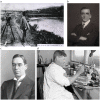Lost Lessons of the 1918 Influenza: The 1920s Working Hypothesis, the Public Health Paradigm, and the Prevention of Deadly Pandemics
- PMID: 36007204
- PMCID: PMC9480479
- DOI: 10.2105/AJPH.2022.306976
Lost Lessons of the 1918 Influenza: The 1920s Working Hypothesis, the Public Health Paradigm, and the Prevention of Deadly Pandemics
Abstract
In standard historical accounts, the hyperlethal 1918 flu pandemic was inevitable once a novel influenza virus appeared. However, in the years following the pandemic, it was obvious to distinguished flu experts from around the world that social and environmental conditions interacted with infectious agents and could enhance the virulence of flu germs. On the basis of the timing and geographic pattern of the pandemic, they hypothesized that an "essential cause" of the pandemic's extraordinary lethality was the extreme, prolonged, and industrial-scale overcrowding of US soldiers in World War I, particularly on troopships. This literature synthesis considers research from history, public health, military medicine, veterinary science, molecular genetics, virology, immunology, and epidemiology. Arguments against the hypothesis do not provide disconfirming evidence. Overall, the findings are consistent with an immunologically similar virus varying in virulence in response to war-related conditions. The enhancement-of-virulence hypothesis deserves to be included in the history of the pandemic and the war. These lost lessons of 1918 point to possibilities for blocking the transformation of innocuous infections into deadly disasters and are relevant beyond influenza for diseases like COVID-19. (Am J Public Health. 2022;112(10):1454-1464. https://doi.org/10.2105/AJPH.2022.306976).
Figures




Comment in
-
Extreme Overcrowding and Extreme Lethality During the 1918 Influenza Pandemic.Am J Public Health. 2022 Oct;112(10):1372-1373. doi: 10.2105/AJPH.2022.307060. Epub 2022 Aug 25. Am J Public Health. 2022. PMID: 36007203 Free PMC article. No abstract available.
Similar articles
-
Overcrowding and Mortality During the Influenza Pandemic of 1918.Am J Public Health. 2016 Apr;106(4):642-4. doi: 10.2105/AJPH.2015.303018. Am J Public Health. 2016. PMID: 26959269 Free PMC article.
-
[Covid-19 and the 1918-1919 influenza: historical parallels, questions and answers].Hist Cienc Saude Manguinhos. 2021 Jul-Sep;28(3):879-883. doi: 10.1590/S0104-59702021005000008. Hist Cienc Saude Manguinhos. 2021. PMID: 34346994 Spanish.
-
Social and institutional Reactions to the Influenza Pandemic of 1918-20.Med Confl Surviv. 2020 Dec;36(4):315-332. doi: 10.1080/13623699.2020.1820165. Epub 2020 Sep 10. Med Confl Surviv. 2020. PMID: 32911978
-
Death from 1918 pandemic influenza during the First World War: a perspective from personal and anecdotal evidence.Influenza Other Respir Viruses. 2014 Sep;8(5):538-46. doi: 10.1111/irv.12267. Epub 2014 Jun 27. Influenza Other Respir Viruses. 2014. PMID: 24975798 Free PMC article. Review.
-
The 2009 influenza pandemic: promising lessons for antiviral therapy for future outbreaks.Curr Med Chem. 2011;18(35):5466-75. doi: 10.2174/092986711798194397. Curr Med Chem. 2011. PMID: 22087838 Review.
Cited by
-
100-Day Mission for Future Pandemic Vaccines, Viewed Through the Lens of Low- and Middle-Income Countries (LMICs).Vaccines (Basel). 2025 Jul 21;13(7):773. doi: 10.3390/vaccines13070773. Vaccines (Basel). 2025. PMID: 40733750 Free PMC article. Review.
References
-
- Johnson NP. Britain and the 1918–19 Influenza Pandemic: A Dark Epilogue. New York, NY: Routledge; 2006.
-
- Crosby AW. America’s Forgotten Pandemic: The Influenza of 1918. New York, NY: Cambridge University Press; 2003. - DOI
-
- Jordan EO. Epidemic Influenza. A Survey. Chicago, IL: American Medical Association; 1927.
-
- Callender GR, Coupal JF. Pathology of the acute respiratory diseases and of gas gangrene following war wounds. In: Lynch C, editor. The Medical Department of the United States Army in the World War. Vol. 12. Washington, DC: US Government Printing Office; 1929.
MeSH terms
LinkOut - more resources
Full Text Sources
Medical

